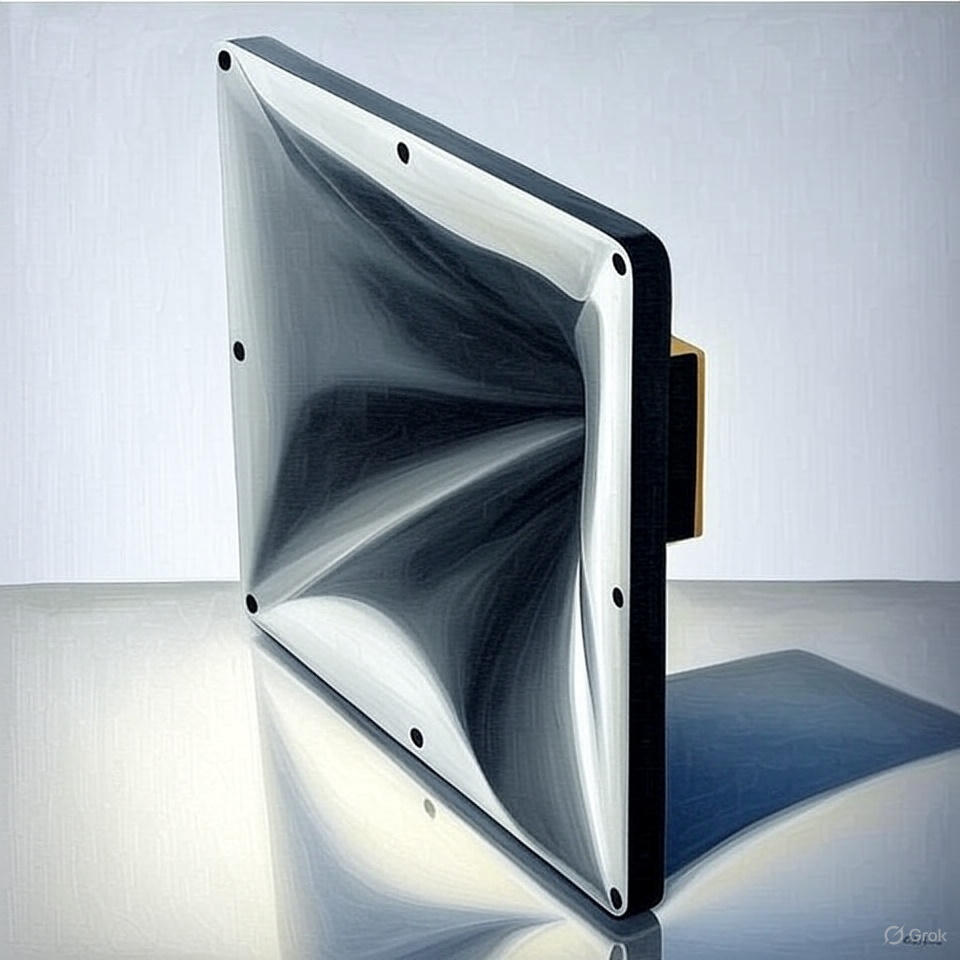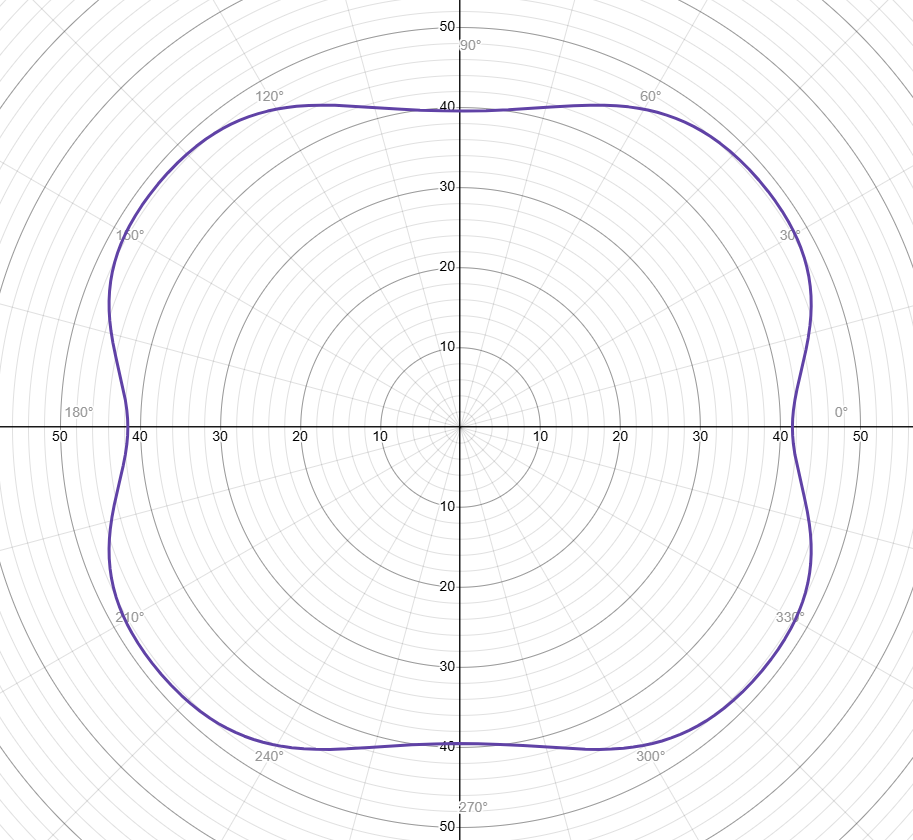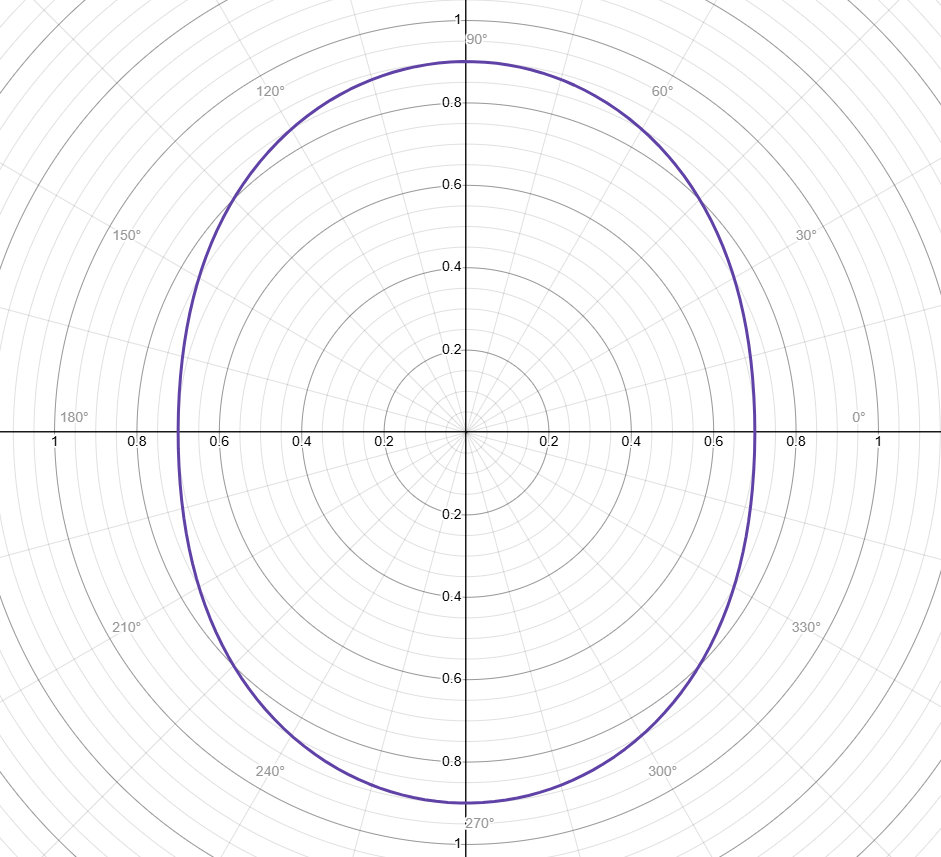


(horizontal, vertical and diagonal polar map)

| Tritonia-XS | Tritonia-S | Tritonia-M | Tritonia-F |
The waveguide called Tritonia was one of the first ATH designs using the smooth curvature transition of the OS-SE[1] profile. It was originally designed for a 1.4" throat and optimized for infinite baffle (or in-wall) conditions. At the time it was believed that to eliminate the on-axis problems associated with most round waveguides (of that time), one has to make the mouth less symmetric - elliptical or rectangular, for example. This was before the advent of the latest free-standing devices, but the original design is still quite good and can be used in a typical loudspeaker enclosure, if preferred for whatever reason.
The performance for infinite baffle conditions is pretty exceptional (see Fig. 1). To come close with a real enclosure, it's recommended to make the front baffle around the waveguide as small as possible and to round the edges generously.
We believe that this set of waveguide kits can still make many audiophiles happy, especially in home theaters. The smaller versions are also very well suited for nearfield monitors. The version "F" is a full-scale version of the original, intended for the most demanding, high-performance installations. All kits have been modified to be used with 1" compression drivers and also for a bit wider nominal coverage.
Included in the packages are also STEP files, allowing further custom modifications of the models in any professional CAD software without loss of quality.




The first kit available, called Tritonia-S (for "small"), is a reduced-scale version of the original, modified for a slightly wider coverage, intended for a 1" compression driver and to be used from roughly 1.5 kHz. The front dimensions are 206 x 178 mm, so the waveguide can be printed in one piece on most 3D printers. The nominal coverage is 100° x 90°, although the enclosure (or lack of) can still alter this to a degree.
The throat opening angle is 20° but it's not really critical in this kind of waveguide with a rapid throat expansion. The internal conical exit section of most compression drivers doesn't allow a perfectly smooth, reflection-free transition anyway. There are no replaceable throat adapters for this design.
It's not strictly necessary to build it into an enclosure, it can be left standing (for example) on a midbass cabinet, although the performance will typically suffer to a degree (you can see such results here). A properly rounded enclosure should provide the best acoustic conditions. Anyway, in the kit there are several versions of the waveguide for different mounting options. Complete Ath code is provided so it's possible to simulate the waveguide in a custom enclosure even before purchasing the kit.
 Tritonia-S / Model Kit |
 Tritonia-S / Ath code |
 Tritonia-S / Drawing |

The second kit is still a 1"-throat, reduced scale version of the original, but larger than the "S" version. The front dimensions are 294 x 254 mm (11.6" x 10"). It's also designed to be printable basically in one piece on larger 3D printers. Its acoustic qualities are maintained and extended to a bit lower frequencies. It's supposed to be used down to 1 - 1.2 kHz, depending on a driver used.
 Tritonia-M / Model Kit |
 Tritonia-M / Ath code |
 Tritonia-M / Drawing |

The XS version is the smallest of the Tritonia models (and there probably won't be anything smaller than this). The front dimensions are only 140 x 122 mm (5.5 x 4.8") and the coverage angle is also the widest of all the models (approx. 110°). It's supposed to be used from around 2 kHz, depending on a driver used, but it's assumed that rather smaller drivers will be used with this waveguide.
Several versions of the waveguide body are included in the package, with different throat diameters: 1", 0.75" (B&C) and 0.63" (BMS). This can be an interesting alternative to the smaller shallow waveguides normally used with dome tweeters.
Tritonia XS is also a very easy FDM print.
 Tritonia-XS / Model Kit |
 Tritonia-XS / Drawing |




This is the full-scale version of the original waveguide, adapted for 1" throat. This waveguide can be used in top-performance classic loudspeakers with a 15" woofer.
The front dimensions are 422 x 364 mm (16.6 x 14.3"). Nominal coverage is 100° and is fairly constant from 800 Hz to 16 kHz. A waveguide this big can be already quite demanding to make and it's available for those with enough courage and also some experience. Included in the kit package are also STEP files suitable for any custom modifications of the waveguide, or a preparation of a different manufacturing process (CNC, mold making, etc.).
 Tritonia-F / Model Kit |
 Tritonia-F / Drawing |



Here's a bit of background of the waveguide origin. The truth is that the very first shape came about by a mere accident. Due to a bug in the design software (ath), the walls of a tested waveguide (one of many) got a bit twisted. Checking the acoustic performance out of curiousity, it was virtually perfect! Definitely something worth pursuing further. This accidental waveguide gave a great performace but the appearance still left a bit to be desired - there's no way something ugly could sound really good!
So the next objective was obvisouly to find the core of what makes the performance and utilize this knowledge in something visually more appealing. The result is the Tritonia waveguide as presented. In the end it was possible to leave out any twisting, the resulting shape is simply symmetrical in the horizontal and in the vertical planes (I tried to find the original shape to show it here, but to no avail, it seems lost forever). Quite a large number of different shapes were tested, from simpler to even far more exotic, but none of those were ever better than the final Tritonia shape.
The final design of the waveguide uses two basic techniques: 1) a parametrized OS-SE profile and 2) morphing it to a rounded rectangle. The core lies in the variable coverage angle parameter of the OS-SE formula:

To improve it further, the mouth termination flare is also adjusted:

The rest of the OS-SE parameters remain fixed:
\(k = 1, n = 3.7, q = 0.995\)The above parameters are for the original 1.4" Tritonia waveguide. For the purpose of the presented kits, the parameters were adjusted to provide the best overall performace for their size(s). There are still no diffraction slots in the throat and so the acoustic impedance remains exceptionally clean through the whole band. Also note that the parameter \( \alpha_0 \) (throat opening angle) is still used independently, so the exit angle of the driver can be matched perfectly everywhere, even though it's not that critical in this kind of rapidly expanding throat.
The next step is the morphing phase, as described in [1], which takes the raw OS-SE shape and transforms it into a device with a rectangular mouth. This is partly motivated by the looks, but it actually adds the last bits of perfection, as it seems to mimic the "twisting" action by adding another, slightly shifted diagonal. Because of the low mouth aspect ratio (~0.86), the overall radiation pattern is also stable and virtually symmetric without flipping.
What started as an accident became a pretty sophisticated design procedure.
You can now enjoy the results of this endeavour!

